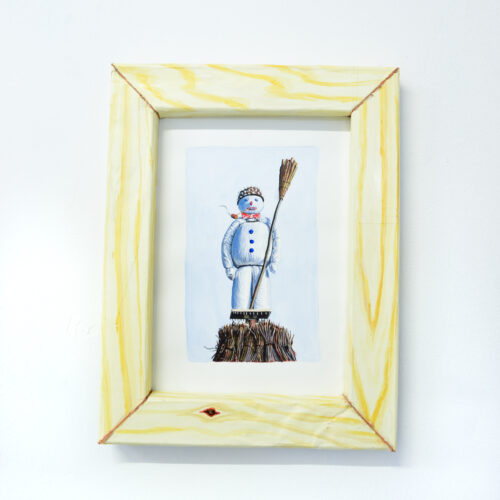Man isst was man isst
Film made in 2025 thanks to a research grant awarded by the Geneva Cultural Service
After “Flunked”, I wanted to make a less narrative animated film and work on the relationship between matter and animation in order to offer a reflection on stop-motion. I wanted to explore what fascinates me about this medium: animating the inanimate, bringing it to life. To play with this ambiguity, I animated perishable, organic materials, which allowed me to highlight their decomposition process. The result is a composition reminiscent of a classic still life. After a short while, the song “Life Is Life,” taken from a video of Diego Maradona training – with the sound of the crowd still audible – begins to play, and a character made of organic, edible materials gets up and starts dancing. It dances and dances, and as they do so, we can observe the different elements rotting and falling apart, and see the change that time has wrought on the character.
This film allowed me to continue my practice of sculpture and installation in a different way, where I like to work with fragile materials and put them to the test with techniques and crafts that I repurpose in a “DIY” way. The temporal dimension is important here: the animated elements become a kind of clock bearing witness to the filming time, where two weeks are reduced to three minutes.
Link: https://youtu.be/1PsF5yV5RC8
Feu de tout bois
Duo exhibition with Brieg Huon at atelier Flemme in Paris
12.06.25-19.06.25
The first thing that catches the eye is the presence of wood, a material treated differently by the two artists: Brieg Huon uses it to create sculptures that serve as frames for his drawings, giving shape to a body of work that, according to Carin Clonowski, is “imbued with the question of the animation of objects, which he approaches with a humorous phantasmagoria” and whose “sculptures, with their retro and cartoonish look, humorously shift their minimalist reference and give patina and warmth to flat-pack furniture.”
For Paul Hutzli, wood exists as trompe l’oeil, a practice that is more broadly part of his work. Having no preferred medium, he often borrows techniques and materials from carnival, culinary, or DIY crafts, which he approaches as a self-taught artist. In this exhibition, he uses papier-mâché repainted and varnished in the style of Basel carnival mask craftsmanship. This technique, which was once used to make furniture and sumptuous decorations such as those in Marie-Antoinette’s theater, is now relegated to children’s crafts and amateur hobbies. Paul Hutzli thus explores the concept of the fake and its use in art. By advocating the mixing of genres, scholarly practices—or those considered as such—and others, those belonging to the fine arts and those considered artisanal, he dismantles and pokes fun at these artificial classifications. Playful, his work retains the essence of carnival, which is nothing more than a time of reversal of values in order to better question them.
The exhibition allows these very different practices, which nevertheless share a common interest in the relationship between craftsmanship and art, to resonate: wood, real or fake, provides common ground on which each artist’s own themes and inspirations can flourish.











